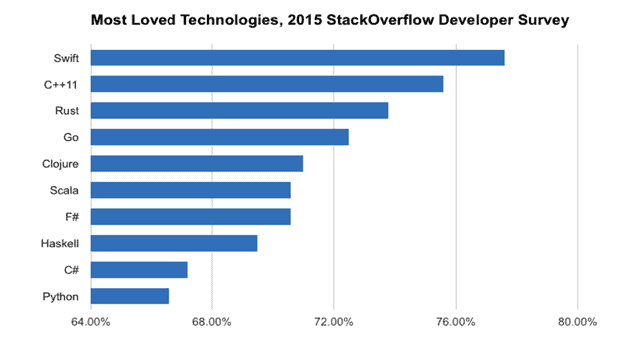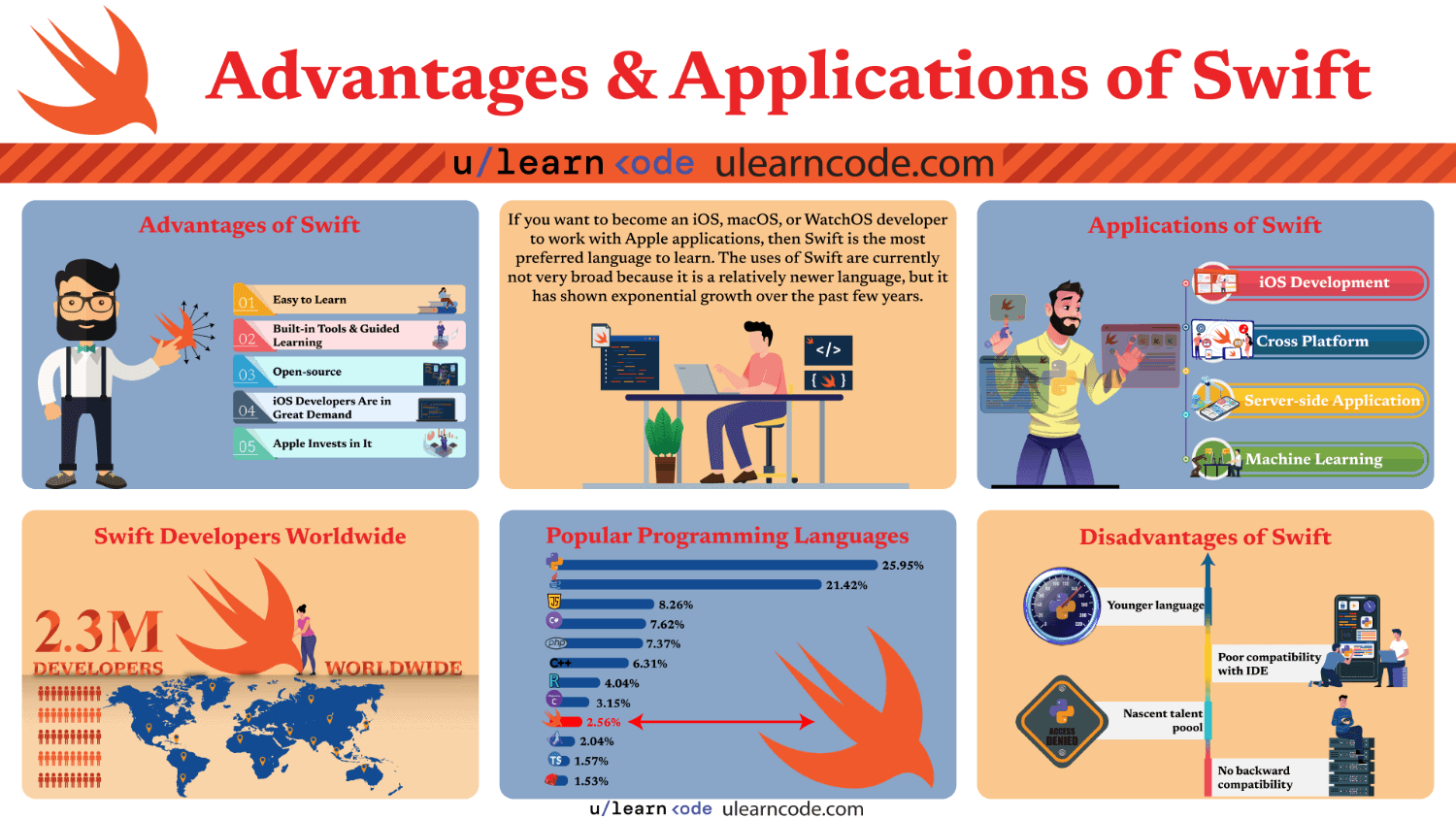Contents
Apple Inc. saw the need for a modern programming language intended to be used in their iOS systems and products. They came up with Swift in 2014, which pretty much replaced the Objective C language in terms of usage.
Swift is a general-purpose compiled programming language which was given the approval of most of the developers in StackOverflow’s survey.

Apple decided to make Swift an open-source language in 2015 so that more developers could contribute to and utilize this language to create iOS and OS X apps for desktop.
Swift is a performance-oriented language and Apple claims it to be 8.4x faster than Python and 2.6x faster than Objective-C. The language is more focused on Apple’s platform, but there are a number of applications that need to be discussed.
Where Swift Is Used?
Most of us know Swift as an iOS development language but it is growing beyond with new frameworks and applications.
1. iOS Development
Objective-C was previously used for iOS app development, but Swift took over this market because of its reliability. Swift is now being widely used in numerous Apple systems such as:
- iOS
- TvOS
- MacOS
- WatchOS
iOS development was difficult before the release of Swift: slower, less reliable, and more insecure due to a number of vulnerabilities.
Swift gives more freedom to the developers with a lot of flexibility to create responsive applications for different Apple platforms. Swiftic is a popular framework that is being used to create interactive iOS applications in a more secure environment.
Although Swift is reliable for Apple platforms, some other iOS Development languages such as Python and C# exist to offer native applications using different frameworks.
iOS developers are in great demand because of Apple’s immense growth, and you can also contribute to their platforms by learning from the best iOS development courses.
2. Cross-Platform Development
Many programmers have a big misconception that Swift can only be used to program applications for iOS platforms, which is not entirely true.
When we open XCode (The Popular Swift IDE), almost all templates are related to Apple Software, but some frameworks make cross-platform development possible using Swift.
SCADE environment makes Swift cross-platform development possible and it uses vector technology for interactive interfaces. AutoLayout was released in SCADE for mobile UI development for the Android platform.
Scade is currently in the development stage but still it is capable of creating cross-platform applications to some scale. If you want to learn more, join your best cross-platform application development course to learn about this interesting topic.
Several cross-platform development languages and tools such as React Native, Xamarin, and Flutter are available to create excellent applications for multiple platforms using:
- JavaScript
- Java
- Python
3. Server-Side Applications
Swift can be used in modern server applications. It is known for its small memory footprint and compiled performance, which makes it a reliable choice for server applications.
A Swift Server work group has also been formed by Apple to embed server-side capabilities in Swift language. This group attempts to provide the best practices, recommendations, and tools to make Swift a server-side language.
Some popular server-side frameworks such as Vapor 4 and Kitura can be integrated by the Swift server community because these frameworks are capable of developing server-side applications.
Currently, there are some other server-side languages such as PHP, Python, and Ruby which are being widely used in server-side programming.
If you are interested in server-side development, then polish your skills by choosing the best server-side programming courses for both beginners and professional programmers.
4. Machine Learning
Swift is not commonly used for Machine Learning (ML) but is slowly entering this domain. It does not include many libraries for ML, but the language has great Python interoperability.
Swift allows you to import any Python libraries to work with ML or any such applications. C and C++ libraries are also importable, which further increases the capabilities of the language.
Libraries and packages that Swift does not include can be imported from other languages to achieve that specific functionality, whether it’s for Machine Learning or Deep Learning.
Some other Machine Learning languages such as Python, R, and Java are seen to be more functional due to the range of their relevant frameworks. You can pick any of these languages to start creating your own algorithms by learning from any of the best Machine Learning courses.
Why Is Swift Worth Learning?

There are numerous reasons to learn Swift, especially if you want to get into iOS development.
1. Easy to Learn
Swift is a very user-friendly language with most of its concepts borrowed from C language. There are many built-in features and algorithms that can be embedded into your programs with less coding.
2. Built-in Tools & Guided Learning
As a modern language, Swift was created with beginner programmers in mind. The Swift Playgrounds app was originally made to educate beginners with zero knowledge. If you want to learn a few advanced concepts, then you can start with the best Swift courses for further guidance.
3. Open-source
Apple made Swift an open-source language in 2015 and since then many developers have contributed their part by forming collaborations to create new language features.
4. iOS Developers Are in Great Demand
According to CompTIA Research, around 80,000 roles were open for app developers in 2019. This number has exponentially increased in 2020, so the market is still full of opportunities.
5. Apple Invests in It
A trillion-dollar company stands behind this language, which offers you continuous community support for any language-related issues. Moreover, Apple is actively investing in Swift to broaden its applications.
Wrapping It Up
If you want to become an iOS, macOS, or WatchOS developer to work with Apple applications, then Swift is the most preferred language to learn. The uses of Swift are currently not very broad because it is a relatively newer language, but it has shown exponential growth over the past few years.